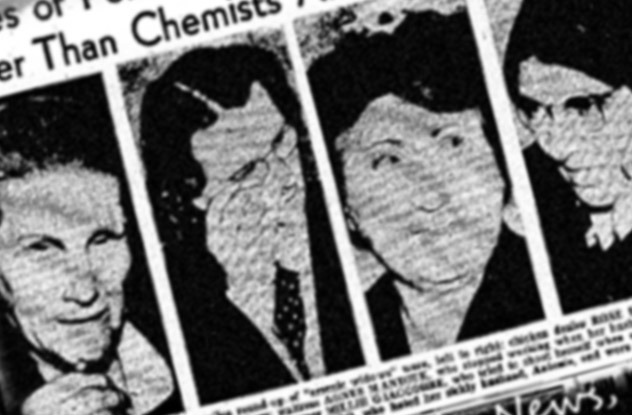[h/t Listverse]
Philadelphia Poison Ring
Cousins Herman and Paul Petrillo were career criminals from Philadelphia who decided to form a matrimonial agency during the 1930s. The purpose of their agency would be to help widowed women remarry and get life insurance policies for their new husbands. However, since the agency functioned as a conduit for collecting money from these policies, the Petrillo cousins and their gang had a vested interest in making sure their clients’ husbands came to tragic ends, often with the wives as willing accomplices.
Paul considered himself to be a practitioner of witchcraft and intended to use black magic to cause the husbands’ deaths. When that didn’t work, they decided to use arsenic instead. And they might have gotten away with it too, but the two couldn’t limit themselves to killing just their clients’ husbands.
In 1938, Herman was having an affair with a woman named Stella Alfonsi and offered to pay an associate to murder her husband Ferdinando. He wanted this associate, George Meyer, to hit Ferdinando with a car to make his death look like an accident. Herman later simply poisoned Ferdinando with arsenic because Meyer was taking so long to act. The reason Meyer had delayed action for so long was that he was actually a police informant, working with investigators to catch the Petrillos on an unrelated counterfeiting charge. When Ferdinando died, Meyer talked to the police and launched an investigation.
Authorities now noticed a pattern of Italian immigrants dying of arsenic poisoning throughout Philadelphia. Virtually all these victims had wives who took out life insurance policies through the Petrillos’ agency. The total number of poisoning victims officially attributed to them was 35, though authorities suspected it might have been higher. A total of 14 people from the Petrillo cousins’ gang were sentenced to life imprisonment. Herman and Paul both went to the electric chair.
***
[h/t Wikipedia]
The Philadelphia poison ring was a murder for hire gang led by the Petrillo cousins, Herman and Paul Petrillo, in 1938. The leaders were ultimately convicted of 114 poison-murders and were executed by electric chair in 1941. Paul’s cousin, Morris Bolber, was among the 14 others in the gang, all of whom were sentenced to life imprisonment.
History
Herman and Paul Petrillo were cousins and both were experienced in the world of elaborate crimes. Herman was an expert counterfeiter and Paul was running an insurance scam business. In Philadelphia, they joined forces with Morris Bolber to establish a “matrimonial agency.” The three men were ostensibly helping recently widowed women to remarry, move on with their lives, and establish life insurance policies for their new husbands; however, the agency functioned as a conduit to collect money from the life insurance policies.
Vincent P. McDevitt was an Assistant District Attorney in Philadelphia. In early 1939, the District Attorney, Charles F. Kelley, assigned him to the homicide case of Ferdinando Alfonsi, who had died on 27 October 1938. McDevitt immediately had information from two undercover detectives, agents Landvoight and Phillips. From them, McDevitt had an informant, one George Meyer, who ran a local upholstery cleaning business. Meyer encountered Herman Petrillo when he was trying to obtain money for his business. Petrillo had offered to provide him with a large sum of money, legal tender and counterfeit, if Meyer would perform the hit on Alfonsi. Landvoight and Meyer had played along with the murder plot, with Meyer hoping for an advance pay-out and Landvoight hoping to finally bust Petrillo’s counterfeiting crimes. Working undercover, Landvoight helped Meyer “play along,” as the Petrillos plotted the murder that they wanted Meyer to carry out.
Murder
The plan was to steal or buy a car, take Alfonsi out to a dark country road and hit him with the car, thus making the murder looking accidental. Herman Petrillo preferred the idea to steal the car rather than buy one, but Landvoight and Phillips were hoping to convince Petrillo to give them money to buy a car for the murder, as it would give them the opportunity that had so long prayed for, to arrest him on counterfeit charges. In the end, Petrillo sold them some fake tender, ostensibly for buying a means of transportation to the planned crime scene. The “play along” plan continued until Meyer, on a whim of curiosity and concern, decided to visit the intended murder victim. At the front door of the house where Alfonsi lived, Meyer learned from an old woman who had opened the door that Alfonsi was gravely ill. After notifying Phillips, he returned with Phillips and Landvoight to the Alfonsi house. They found Alfonsi to be bizarrely ill, suffering symptoms of bulging eyes, immobility, and being unable to speak. At their next meeting with Herman Petrillo, after Petrillo handed Phillips an envelope full of counterfeit bills, Phillips asked about the plan to murder Alfonsi. Petrillo replied that there was no reason to worry about it anymore; it was being handled, apparently.
Investigation
Ferdinando Alfonsi expired after being admitted to the National Stomach Hospital. The cause of death was heavy metal poisoning. The autopsy revealed tremendousarsenic levels. The detectives assigned to the case were Michael Schwartz, Anthony Franchetti, and Samuel Riccardi. They instantly thought of the rumors, already well-developed, about a highly organized arsenic killing spree surging through the city. Indeed, there were distinct patterns. The victims tended to be Italian immigrants, as Alfonsi was, and to have high levels of arsenic in their bloodstreams.
Herman Petrillo and Mrs. Alfonsi were both arrested. Mrs. Alfonsi had purchased a sizable life insurance policy for her husband, an immigrant who could not read English and had been unaware of the policy. Moreover, the Alfonsi case fit with a rapidly-emerging common Modus operandi in a lot of other homicide investigations. Most importantly, each case involved a fresh life insurance policy with a double indemnity clause and a nearly-direct lead to one of the Petrillo cousins, and each cause of death was listed as some sort of violent accident.
